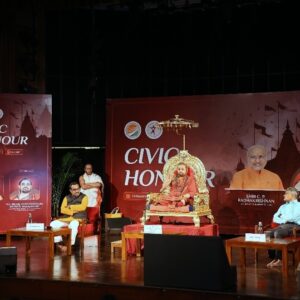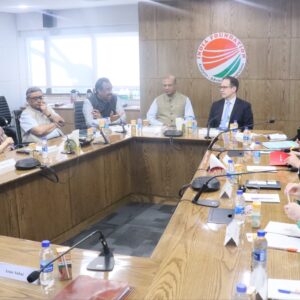
 India Foundation, New Delhi organized a Discussion on “Worldwide Terror Trends: Terrorist Tactics, Targets and Weapons” at the India International Centre (IIC), New Delhi on April 13, 2015. The Keynote Speaker was Prof. Gary LaFree, Director, National Consortium for the Study of Terrorism and Responses to Terrorism (START), University of Maryland, USA.
India Foundation, New Delhi organized a Discussion on “Worldwide Terror Trends: Terrorist Tactics, Targets and Weapons” at the India International Centre (IIC), New Delhi on April 13, 2015. The Keynote Speaker was Prof. Gary LaFree, Director, National Consortium for the Study of Terrorism and Responses to Terrorism (START), University of Maryland, USA.
The discussion initiated with the welcoming of Prof. Gary LaFree. Capt. Alok Bansal, Director, India Foundation delivered the Opening Remarks by observing that terrorism has become the biggest threat to global peace in the 21st Century. There is a dire need for nations across the world to come together and collaborate to tackle this global menace. Over the years, India Foundation has been dedicated to come up with path breaking ideas and initiatives to counter terrorism. Recently, the Foundation had organized the 1stInternational Conference on Counter-Terrorism in Jaipur, Rajasthan that was hugely participated and appreciated by the experts and academics from across the world.
Prof. LaFree began his note by thanking India Foundation for giving him this opportunity to speak on this significant topic. He went on to describe the activities and objectives of the research organization, Study of Terrorism and Responses to Terrorism (START). START advances science-based knowledge about the human causes and consequences of terrorism as a resource for homeland security policymakers and practitioners. It has been recognized by Department of Homeland Security, USA for outstanding contributions to the security of the United States for its long-term support of the Global Terrorism Database (GTD), an open-source database including information on more than 1,25,000 domestic and international terrorist events around the world since 1970 through 2013.
Prof. LaFree, referring to the database generated by START since 1970 till 2013, demonstrated that there has been a rapid increase in the number of terrorist attacks over the past four decades with the lowest number of attacks in 1970-72 and 1998-99.However, since then, the terrorist activities have been on rise with the highest in 2012-13. He then talked about the Terrorism Hotspots. According to GTD, the concentration and intensity of the terrorist attacks depending upon the combination of incident fatalities and injury can be seen in most parts of Pakistan, Afghanistan, Iraq, Bangladesh and Eastern and South Eastern region of Indian subcontinent.
Prof. LaFree, through his well-consolidated database in the presentation, pointed out the topmost countries with most terror attacks and fatalities from 1970 to 2013. Iraq is the one country with most terror attacks and fatalities while India being at number 3 with a total of 8207 attacks resulting in 17496 fatalities.Moving on to the different types of weapons used in terrorist attacks, he observed that explosives, bombs, dynamites are the most common weapons including firearms. Also, in the course of his presentation he identified the top twenty perpetrator organizations around the world that included Taliban with most number of attacks and fatalities along with ISIL, Al-Shabaab, Boko Haram and Naxal wing of Communist Party of India. On the other hand, the top terrorist groups that have been active in India over the last four decades include (CPI-M), Sikh Extremists, Maoists, United Liberation Front of Assam, etc.
The most important concept introduced by Prof. LaFree during his presentation was the concept of understanding terrorism according to David Rapoport’s “Waves”. Rapoport theorized that terrorist activity could be uniquely characterized by “Waves” of specific types of terrorism. He also categorized different types of terrorist “Waves” including Anarchist Wave (1880s-1920s); Anti-Colonial Wave (1920s-1960s), New Left Wave (1960s-1990s) and Religious Wave (1979-current).
The discussion was then followed by an interactive question and answer session. There were varied questions ranging from collection of data, data related issues and analyzing nature of terrorist attacks in the recent past.
Sh. Manohar asked, “What do you think is the reason for less number of suicide attacks in India, particularly in Kashmir?” To which Professor LaFree responded, “We have found dramatic differences in the data of different countries as per the suicide attacks are concerned. We have observed that over the time, a higher number of groups (but specific groups) have started adopting suicide attacks.” Sh. Ram Madhav, Director, India Foundation observed, “India has witnessed such attacks in which there is no escape for the perpetrators – they are quite similar to the suicide attacks.”
Sh. Nalapat made an observation on the ‘Idea of waves’ that goes up, peaks and comes down. He subsequently questioned,“What are the reasons and causes behind the waves of terrorist attacks/groups?” To which Professor LaFree observed, “Our data includes all major attacks that have had the highest number of fatalities and also the attacks that didn’t kill anyone. It is quite impossible to club these groups and determine some common causes behind their attacks.”
Sh. Ram Madhav asked, “Do u have any data that highlights the motivations behind terrorist attacks?” To which Prof. LaFree observed, “This is virtually impossible for an organization like us to determine the motivation of groups around the world. We have data primarily for US. We can identify factors – sociological issues, radicalizing groups, social and political movements, etc. But it is beyond our ability to come up with a consolidated data for the world.”
After the fruitful discussion, Capt. Alok Bansal, Director, Centre for Security & Strategy (CSS) delivered the vote of thanks with a special mention to Prof. LaFree for taking time out of his busy schedule and presenting a brilliant discourse on trends, tactics, targets and weapons in International Terrorism.



